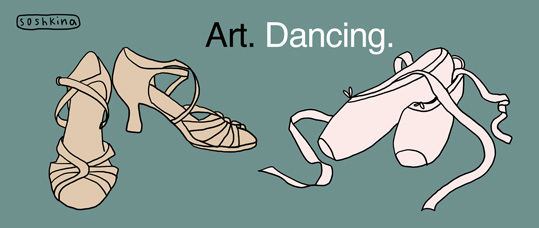Art. Dancing
Step forward, step back, turning, stamp the rhythm, jump, swing … Those who love the art of dance can't help agreeing with the words of American choreographer Adam Darius: “Dance can reveal the deepest feelings that are liberated by body movements”.
Dance has existed in cultural traditions of all societies. For the long human history it has constantly been changing and developing. With the help of dance we can see and feel music. There are plenty of kinds, styles and forms of dance. And ballet, without doubt, sets things in motion in the art of dancing.
Ballet is a type of performance dance that originated in the Italian Renaissance royal courts of the 15th century, and which was further developed in France and Russia as a concert dance. Nowadays ballet is primarily performed on stage with the accompaniment of classical orchestral music. Ballet has been taught in ballet schools around the world and has acquired the traditions and style of different cultures and societies. Ballet dance works (ballets) are choreographed and shown by trained artists, and include mime and acting. It is a poised style of dance that incorporates the foundational techniques for many other dance forms. This genre of dance is very hard to master and requires much practice.
Some of ballet's beauty and mystique comes from the elegant satin slippers worn by ballerinas. However, although ballet dates back to the 15th century the use of ballet slippers and pointe shoes is relatively recent. Marie Taglioni was the first recorded dancer to dance en pointe (that is, on 'tippy toes'), in 1832. The development of ballet shoes was one of the primary factors that allowed ballet to become the highly technical and challenging art that it is today. And the ballet dancer's fluffy skirt, with layers of underskirts is called tutu.
Ballroom dancing is an absolutely different world that deserves admiration. Numerous ballroom dancing championships are aimed at evaluating the dancers' mastery in two programs: European and Latin American. The European program includes such dances as: slow waltz, European tango (shouldn't be mixed up with Argentinean tango that is a separate type of dance), Viennese waltz, foxtrot and quick step (that is fast foxtrot). For these dances a lady-partner is required to wear a light-colored ball-gown that is normally long and loose. It can be decorated with feather, lace and ribbons. A man-partner usually looks elegant wearing a dark costume that resembles a tuxedo or a tail-coat.
Latin American program consists of the following types of dance: samba, cha-cha-cha, rumba, paso doble and jive (that is a variety of swing). The majority of the above dances are fiery, passionate and rhythmical ones with a lot of lifts and acrobatic elements. That's why the dancers' costumes, that are called Latina, are totally different. A woman's dress is of a bright color, tight and can be very short. Possible decorations are frills and sequins. A man wears slinky dark trousers and a Latina shirt that has loose, long sleeves or even frills.
Among other types of dance we can find acrobatic rock-n-roll, swing, boogie-woogie; Latin American dances like salsa, bachata, merenge; Argentinian tango,flamenco, Irish jig; street dances like break-dance and hip-hop; folk dances of different nationalities; contemporary dance and lots of others.
The art of dance is boundless and variegated. Go for it and you will never feel alone in the world of the “poetry of movement”.
















